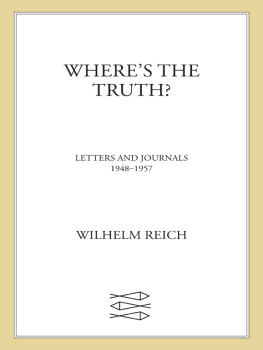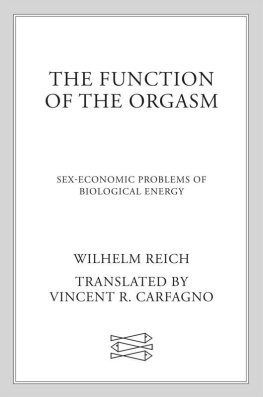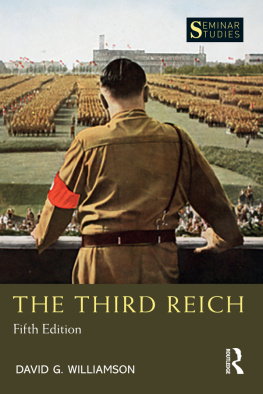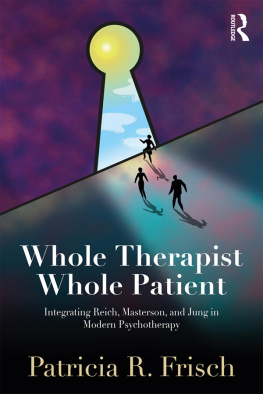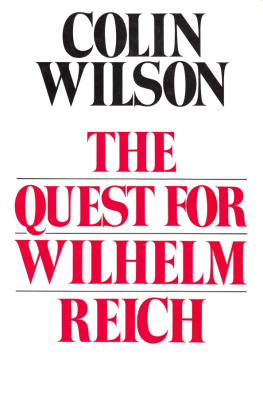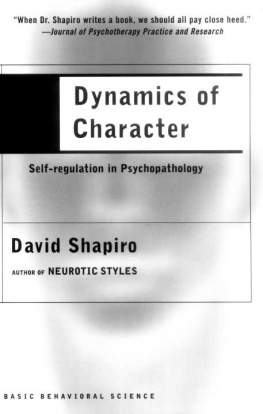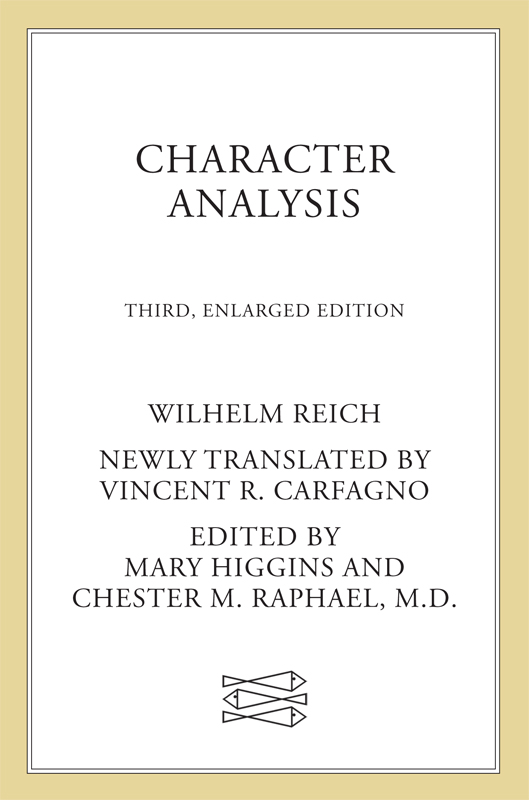
The author and publisher have provided this e-book to you for your personal use only. You may not make this e-book publicly available in any way. Copyright infringement is against the law. If you believe the copy of this e-book you are reading infringes on the authors copyright, please notify the publisher at: us.macmillanusa.com/piracy.
Contents
Love, work and knowledge are the wellsprings of our life. They should also govern it.
WILHELM REICH

EDITORS NOTE
This new translation of the third, enlarged edition of Character Analysis has been prepared from the original German language book and manuscripts with the exception of the preface to the third edition and the chapter on The Schizophrenic Split which were written in English by the author.
It was discovered that, except for a few minor changes, the note preceding The Masochistic Character that was previously signed by a translator was, in fact, written by Reich himself. It is, therefore, presented in its original form in this translation.
It should also be noted that the chapter entitled The Emotional Plague, written in 1943 and slightly revised by Reich before its inclusion in Character Analysis, has been placed at the end of the book so that its terminology will be comprehensible within the context of this work and, also, to enable the reader to follow without interruption Reichs development from character analysis to orgone biophysics.
Mary Higgins, Trustee
The Wilhelm Reich Infant Trust Fund
New York, 1972
PREFACE TO THE THIRD EDITION
The second edition of this book (1945) was soon sold out, and the great demand for it could not be satisfied for more than two years. Our press was busy with publications devoted to the newer field of orgone biophysics ( The Discovery of the Orgone, Vol. II: The Cancer Biopathy, 1948, etc.). Furthermore, I hesitated to issue a new edition of Character Analysis. This book still uses psychoanalytic terminology and a psychological description of the neuroses. In the fifteen years since the publication of the first edition, I had to redesign and rewrite our picture of emotional disease. During this time, many important developments took place: character became a term signifying typical biophysical behavior. The emotions, more and more, came to mean manifestations of a tangible bio-energy, of the organismic orgone energy. Slowly, we learned to handle it practically by what is now called medical orgone therapy. In the preface to the second edition, I pointed out that character analysis is still valid in the realm of depth psychology, where it originated and where it still belongs. We no longer practice character analysis as described in this book. However, we still use the character-analytic method in certain situations; we still proceed from character attitudes to the depths of human experience. But in orgone therapy, we proceed bio-energetically and no longer psychologically.
Why then publish a third edition of this book, in its original form? The main reason is that one cannot easily find ones way toward an understanding of orgonomy and medical orgone therapy without being well acquainted with their development from the study of human emotional pathology of twenty or twenty-five years ago.
Character analysis is still valid and helpful in psychiatry, but it is far from being sufficient to cope with the bio-energetic core of emotional functions. It is indispensable for the medical orgone therapist who, without having studied psychoanalysis, comes directly to the orgone biophysics of the 40s. The psychiatrist who has not studied the bio-energetic functions of the emotions is apt to overlook the organism as such and to remain stuck in the psychology of words and associations. He will not find his way to the bio-energetic background and origin of every type of emotion. The orgone therapist, on the other hand, trained to see a patient first of all as a biological organism, may easily forget that, besides muscular armoring, bodily sensations, orgonotic streamings, anorgonotic attacks, diaphragmatic or pelvic blocks, etc., there is a vast field of functioning such as marital distrust, specifically distorted ideas about genital functions in puberty, certain social insecurities and anxieties, unconscious intentions, rational social fears, etc. Although the psychic realm of the emotions is much narrower than their bio-energetic realm; although certain diseases, such as vascular hypertension, cannot be attacked by psychological means; although language and thought association cannot possibly penetrate more deeply than to the phase of speech development, that is, about the second year of life, the psychological aspect of emotional disease remains important and indispensable; however, it is no longer the foremost aspect of orgonomic biopsychiatry.
The third edition of Character Analysis has been considerably enlarged. I have added The Emotional Plague, previously published as an article in the International Journal of Sex-Economy and Orgone Research, 1945. Also, a paper on The Expressive Language of the Living, not previously published. It deals with the realm of biophysical emotional expressions, the main realm of medical orgone therapy. Finally, an extensive case history of a paranoid schizophrenia will introduce the student of human nature to the new field of biopathology which was opened up only a few years ago by the discovery of the organismic orgone energy (= bio-energy). This case history will convince the reader that the organismic orgone energy is the physical reality which corresponds to the classical, merely psychological, concept of psychic energy.
The old term vegetotherapy has been replaced by orgone therapy. Otherwise, the book remains unchanged in its main structure. It represents the essential first step, taken from 1928 to 1934, from psychoanalysis toward the bio-energetic study of the emotions (orgone biophysics) and deserves to be preserved as such.
The discovery of the atmospheric (cosmic) orgone energy has forced major revisions in our basic physical as well as psychological concepts. These are not dealt with in this book. It will take many years of painstaking work to elucidate the main trends which have developed since the discovery of the orgone. Such things as a psychic idea, for example, appear today in an entirely different light, as a result of disclosures made by orgonomic experiments. But this should not distract the psychotherapist and orgone therapist from his everyday task with emotionally sick people. At present, it is mainly the natural scientist and the natural philosopher who are being challenged by the disclosure of a universal primordial energy: orgone energy.
W. R.
December 1948
PREFACE TO THE SECOND EDITION
In the twelve years since the first publication of Character Analysis, the character-analytic technique has developed into vegetotherapy. In spite of this, no changes have been undertaken in the present edition. There is a good reason for this.
The character-analytic technique was clinically worked out and tested between 1925 and 1933. At that time, sex-economy was still in its infancy. The individual and social importance of the function of the orgasm had been recognized only a few years earlier. Naturally, this recognition had considerable influence on the theory and technique of psychoanalytic therapy. Today, as twelve years ago, character analysis definitely belongs within the framework of Freudian psychoanalysis. It was in this framework and only in this framework that this book was written and can still claim validity today. It was intended for students as well as practitioners of psychoanalysis. I do not want to change its original purpose and intention. Hence, I have not added anything, nor have I made any revisions.


